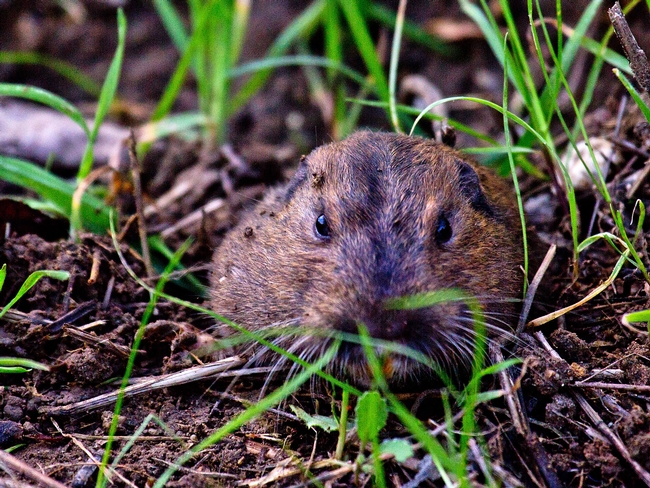
Pocket gophers are rarely seen above ground but sometimes you can see them popping out of a feeding hole. They are small mammals with small eyes and ears and have fur lined cheek pouches (pockets) for storing food.
Pocket gophers are considered nongame wildlife, which means that they can be managed by any legal means. In school and community gardens there are many options.
Trapping
Trapping is one of the easiest ways to curtail a gopher issue in a school or community garden. It is really important to monitor the issue and insure that the problem does not get out of hand since gophers are very prolific breeders and are easier to manage when there are less of them.
There are many trap options for trapping gophers. It is important to consider public safety when using these tools. Traps are often very tightly sprung and could damage fingers and toes of anybody that unexpectedly steps in a set trap. While research has shown that it is not necessary to cover over your trap sets and close them up, it is important to reduce the risk of exposure to a trap, especially in a school setting. It is recommended that trap sets in this scenario should be covered and inaccessible to youth.
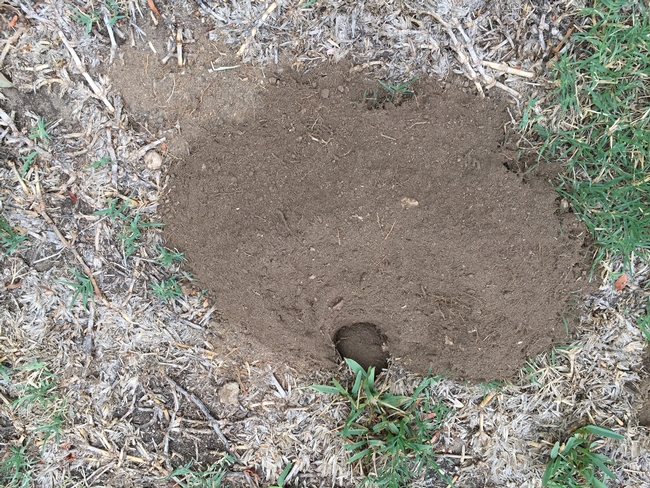
There are some toxicants that are available to unlicensed professionals for use on gophers. The most commonly available products are those containing zinc phosphide. These products are applied below the ground and therefore risk of exposure is very low. Bait shyness can be associated with this active ingredient so it is important to monitor the issue and ensure that it is being reduced. Otherwise, you may be applying rodenticide that is not being consumed.
Fumigation
Fumigation is a common and often successful way to manage gophers. However, many of these products are considered Restricted Use Pesticides and can only be applied by a licensed professional. Products like gas or smoke cartridges are not considered effective for the management of gophers.
Exclusion
Gophers can be excluded from school and community gardens but the costs of installing underground fencing can be cost prohibitive. Instead, consider excluding gophers from smaller areas like raised beds. Remember that gophers can travel above ground too, so if you install wire fencing with a ¾ inch mesh, be sure to extend it above the ground also. Wire baskets can also be used to exclude gophers from the root systems of high value trees and shrubs. You must take care to ensure that these baskets do not restrict the growth of the roots.
For more information on gophers and other vertebrate pest, please visit the UC IPM Pest Notes.
- Author: Niamh Quinn
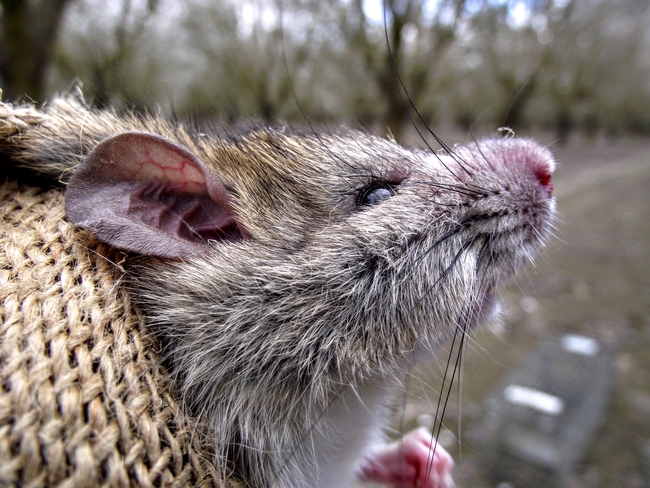
Managing rodents in and around school and community gardens can be difficult. One of the easiest ways to keep many rodents at bay is to remove their food source. Given that the main purpose of a garden is to grow food, it would be counter-intuitive to remove the food. However, there are many management options available to people working in gardens that are trying to protect their food from rat damage.
Habitat modification and sanitation
Making sure that the landscape surrounding your garden is well maintained may help with the management of rats. Lots of cover in the form of landscaped shrubs, trees, untrimmed palm trees etc. can provide a lot of harborage for rats to live in. These should be trimmed up and off the ground and should not be densely planted if they are in the area. Compost can provide ample harborage for rats. It is recommended to not compost food in the immediate vicinity of your garden and any other green waste should be attended to regularly to make sure that rats do not establish colonies in compost piles. Feeding of wildlife is illegal in the State of California. Therefore, the provision of food for any wildlife is illegal. The provision of food is not only illegal but it can also induce secondary pest problems like rodent outbreaks. The feeding of feral cats should also be strongly discouraged, particularly in areas where their feces could contaminate soils and other food.
Trapping
Trapping can be a very useful tool for the management of rats in gardens. If you have a rat problem in your garden it is important to be realistic about the number of snap traps that will be required to manage the issue. One or two snap traps will not curb a population. It is important to saturate an area with snap traps. Consider trapping at multiple levels also (inside beds, outside beds, on the ground, on fence lines etc.). Please be mindful of other community garden volunteers. It is important to let them know where snap traps are to reduce the risk of injury on encountering a snap trap. If you are working in a school, snap traps can be set in the evening and checked in the morning before the children get to the garden. Snap traps should not be set in gardens during the day when children are present unless they are secured in trapping stations that can be provided under contract from a pest management professional. Snap traps can also capture nontarget wildlife such as birds and reptiles. Please be mindful of these when setting traps. Nontarget mortality can be reduced by trapping only at night or by using trapping stations that can exclude nontarget wildlife. It is not advised to live-trap any wildlife in a garden. Once you trap a rat, under law, you must either release it right where you captured it, or euthanize it humanely.
Rodenticides
The use of rodenticides to manage rats in and around gardens is actually not considered legal. The majority of rodenticides available for purchase for unlicensed applicators are for structural use only. It is permitted to have rodenticide in gardens as long as you are using it to control rodents that are invading a man-made structure such as a shed, storage barn, or building. All rodenticides that are registered to manage rats must be applied in bait stations no more than 50ft away from the man-made structure, although some labels permit going further away (up to 100ft).
Placement of snap traps: (a) single trap with trigger next to wall; (b) the double set increases your success; (c) double set placed parallel to the wall with triggers to the outside.
Adapted from The Rat: Its Biology and Control, Howard, W. E., and R. E. Marsh. 1981. Oakland: Univ. Calif. Div. Agric. Sci. Leaflet 2896
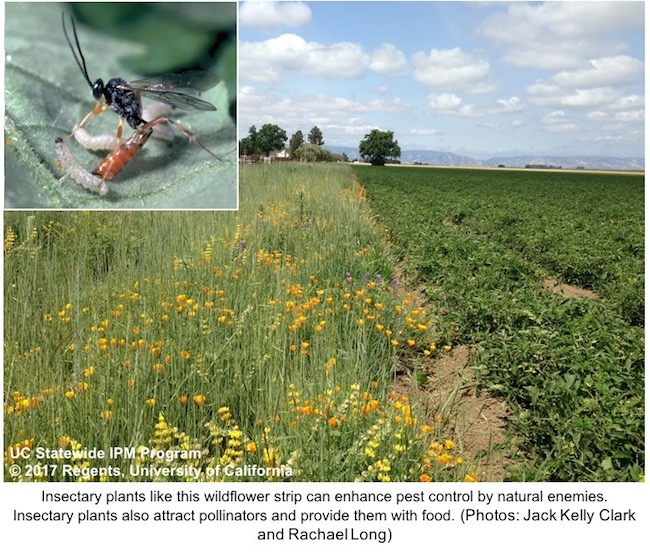
Flowering insectaries also provide food for bees and other pollinators. There are both greater numbers and more kinds of native bees in fields with an insectary consisting of a row of native shrubs planted along the field edge (called a hedgerow). Native bees also stay in fields with these shrubs longer than they do in fields without them. Therefore, not only do insectaries attract natural enemies, but they can also boost crop pollination and help keep bees healthy.
Sources:
- Flower flies (Syrphidae) and other biological control agents for aphids in vegetable crops. (PDF)
- Good news for hedgerows: no effects on food safety in the field.
- Hedgerow benefits align with food production and sustainability goals.
- Habitat restoration promotes pollinator persistence and colonization in intensively managed agriculture. (PDF)
- Reducing the abundance of leafhoppers and thrips in a northern California organic vineyard through maintenance of full season floral diversity with summer cover crops.
- Author: Cheryl A. Wilen
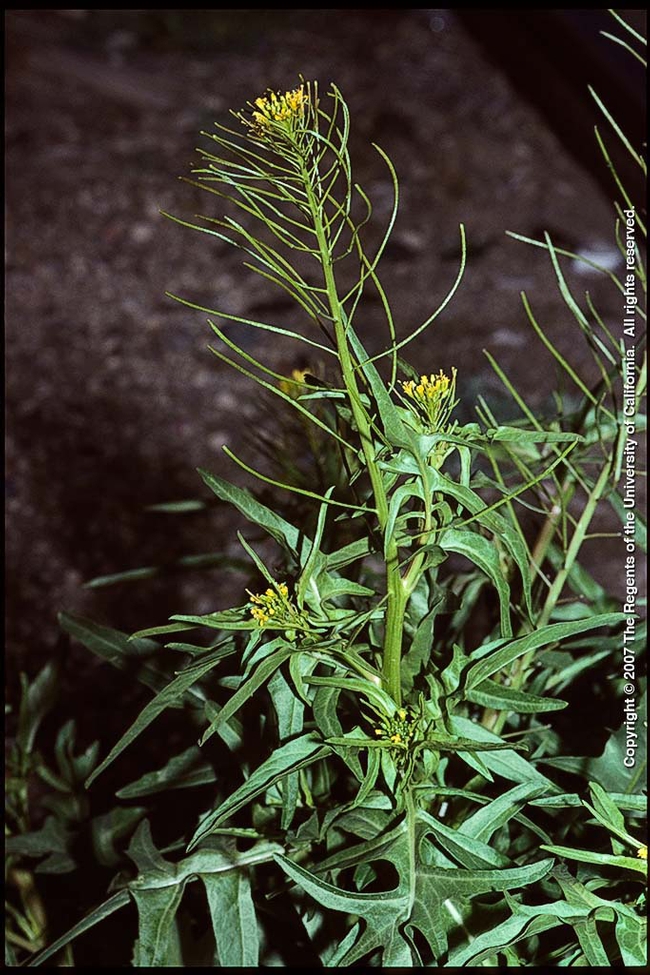
But suppose you miss some weeds that are starting to flower but the flowers aren't open yet? I think most growers will just pull or cut the weed and leave it in or near the field.
I want to show you a time-lapse video I took. I cut the flowering stem off of an annual sowthistle plant and took a photo with a special camera every minute for 6 days. As you can clearly see, even though the stem was no longer receiving water or nutrients from the soil, at least the flower bud continued to mature and produce seeds. Now, having said that, I have not germinated the seeds to see if they are viable, but there is a good chance they are. Click HERE for video. It's about 1 1/2 minutes long, but most of the action happens in the first 50 seconds.
So the take home message - if the weeds have flower buds starting to open, remove them to covered piles, trash cans, or other area where they will not be a source of new weed seeds.
- Author: Andrew M Sutherland, SF Bay Area Urban IPM Advisor
Every year, California receives, on average, six new exotic invasive pests of concern; that's about one new pest every 60 days. These may be plants, insects or other arthropods, mollusks, plant pathogens such as fungi and bacteria, vertebrates, or any other organism not native to our state and with the capacity to negatively impact agriculture, urban environments and/or natural ecosystems. These invasive pests enter California on plant material and other biological substrates, as hitchhikers on trade goods and in ship ballast water, and sometimes even because of smuggling operations. Without the natural enemies that kept them in check in their native lands, they are free to reproduce and wreak havoc. Such pest invasions may then lead to destruction or alteration of habitat, loss of agricultural trade revenues, pronounced losses in agricultural production, and increases in pesticide applications.
The best way to combat such invasions may be through robust exclusion, inspection, early detection, and quarantine programs. Once established, they are best managed using classical and conservation biological control and the decision-making process of integrated pest management (IPM), described in detail in an earlier blog post. Urban agricultural environments are not immune to these invasions and may even be more at risk since urban environments contain many likely routes of introduction and have often been identified as point sources for invasive pests. In this article we will review the biology, ecology, and management of three recent pests that may increasingly be found in urban gardens and other urban ag environments.

PESTNOTES - UC IPM Online: Asian Citrus Psyllid and Huanglongbing Disease
Center for Invasive Species Research: Asian Citrus Psyllid
UC scientists release a natural enemy of Asian citrus psyllid

PEST NOTES - UC IPM Online: Brown Marmorated Stink Bug
Pest Alert - UC IPM Online: Brown Marmorated Stink Bug
Center for Invasive Species Research: Brown Marmorated Stink Bug

PEST NOTES - UC IPM Online: Bagrada Bug




